Xiangyu Xi
Autoformalizer with Tool Feedback
Oct 08, 2025Abstract:Autoformalization addresses the scarcity of data for Automated Theorem Proving (ATP) by translating mathematical problems from natural language into formal statements. Efforts in recent work shift from directly prompting large language models to training an end-to-end formalizer model from scratch, achieving remarkable advancements. However, existing formalizer still struggles to consistently generate valid statements that meet syntactic validity and semantic consistency. To address this issue, we propose the Autoformalizer with Tool Feedback (ATF), a novel approach that incorporates syntactic and consistency information as tools into the formalization process. By integrating Lean 4 compilers for syntax corrections and employing a multi-LLMs-as-judge approach for consistency validation, the model is able to adaptively refine generated statements according to the tool feedback, enhancing both syntactic validity and semantic consistency. The training of ATF involves a cold-start phase on synthetic tool-calling data, an expert iteration phase to improve formalization capabilities, and Direct Preference Optimization to alleviate ineffective revisions. Experimental results show that ATF markedly outperforms a range of baseline formalizer models, with its superior performance further validated by human evaluations. Subsequent analysis reveals that ATF demonstrates excellent inference scaling properties. Moreover, we open-source Numina-ATF, a dataset containing 750K synthetic formal statements to facilitate advancements in autoformalization and ATP research.
Enhancing Efficiency and Exploration in Reinforcement Learning for LLMs
May 24, 2025Abstract:Reasoning large language models (LLMs) excel in complex tasks, which has drawn significant attention to reinforcement learning (RL) for LLMs. However, existing approaches allocate an equal number of rollouts to all questions during the RL process, which is inefficient. This inefficiency stems from the fact that training on simple questions yields limited gains, whereas more rollouts are needed for challenging questions to sample correct answers. Furthermore, while RL improves response precision, it limits the model's exploration ability, potentially resulting in a performance cap below that of the base model prior to RL. To address these issues, we propose a mechanism for dynamically allocating rollout budgets based on the difficulty of the problems, enabling more efficient RL training. Additionally, we introduce an adaptive dynamic temperature adjustment strategy to maintain the entropy at a stable level, thereby encouraging sufficient exploration. This enables LLMs to improve response precision while preserving their exploratory ability to uncover potential correct pathways. The code and data is available on: https://github.com/LiaoMengqi/E3-RL4LLMs
Rethinking the Sampling Criteria in Reinforcement Learning for LLM Reasoning: A Competence-Difficulty Alignment Perspective
May 23, 2025Abstract:Reinforcement learning exhibits potential in enhancing the reasoning abilities of large language models, yet it is hard to scale for the low sample efficiency during the rollout phase. Existing methods attempt to improve efficiency by scheduling problems based on problem difficulties. However, these approaches suffer from unstable and biased estimations of problem difficulty and fail to capture the alignment between model competence and problem difficulty in RL training, leading to suboptimal results. To tackle these limitations, this paper introduces \textbf{C}ompetence-\textbf{D}ifficulty \textbf{A}lignment \textbf{S}ampling (\textbf{CDAS}), which enables accurate and stable estimation of problem difficulties by aggregating historical performance discrepancies of problems. Then the model competence is quantified to adaptively select problems whose difficulty is in alignment with the model's current competence using a fixed-point system. Experimental results across a range of challenging mathematical benchmarks show that CDAS achieves great improvements in both accuracy and efficiency. CDAS attains the highest average accuracy against baselines and exhibits significant speed advantages compared to Dynamic Sampling, a competitive strategy in DAPO, which is \textbf{2.33} times slower than CDAS.
SampleMix: A Sample-wise Pre-training Data Mixing Strategey by Coordinating Data Quality and Diversity
Mar 03, 2025Abstract:Existing pretraining data mixing methods for large language models (LLMs) typically follow a domain-wise methodology, a top-down process that first determines domain weights and then performs uniform data sampling across each domain. However, these approaches neglect significant inter-domain overlaps and commonalities, failing to control the global diversity of the constructed training dataset. Further, uniform sampling within domains ignores fine-grained sample-specific features, potentially leading to suboptimal data distribution. To address these shortcomings, we propose a novel sample-wise data mixture approach based on a bottom-up paradigm. This method performs global cross-domain sampling by systematically evaluating the quality and diversity of each sample, thereby dynamically determining the optimal domain distribution. Comprehensive experiments across multiple downstream tasks and perplexity assessments demonstrate that SampleMix surpasses existing domain-based methods. Meanwhile, SampleMix requires 1.4x to 2.1x training steps to achieves the baselines' performance, highlighting the substantial potential of SampleMix to optimize pre-training data.
Dialog-to-Actions: Building Task-Oriented Dialogue System via Action-Level Generation
Apr 03, 2023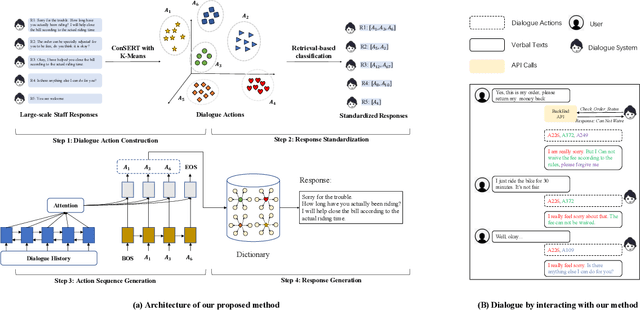
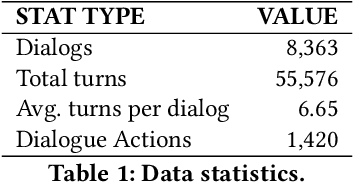
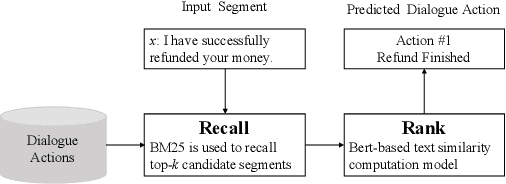
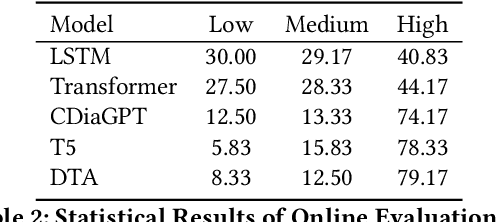
Abstract:End-to-end generation-based approaches have been investigated and applied in task-oriented dialogue systems. However, in industrial scenarios, existing methods face the bottlenecks of controllability (e.g., domain-inconsistent responses, repetition problem, etc) and efficiency (e.g., long computation time, etc). In this paper, we propose a task-oriented dialogue system via action-level generation. Specifically, we first construct dialogue actions from large-scale dialogues and represent each natural language (NL) response as a sequence of dialogue actions. Further, we train a Sequence-to-Sequence model which takes the dialogue history as input and outputs sequence of dialogue actions. The generated dialogue actions are transformed into verbal responses. Experimental results show that our light-weighted method achieves competitive performance, and has the advantage of controllability and efficiency.
MUSIED: A Benchmark for Event Detection from Multi-Source Heterogeneous Informal Texts
Nov 25, 2022



Abstract:Event detection (ED) identifies and classifies event triggers from unstructured texts, serving as a fundamental task for information extraction. Despite the remarkable progress achieved in the past several years, most research efforts focus on detecting events from formal texts (e.g., news articles, Wikipedia documents, financial announcements). Moreover, the texts in each dataset are either from a single source or multiple yet relatively homogeneous sources. With massive amounts of user-generated text accumulating on the Web and inside enterprises, identifying meaningful events in these informal texts, usually from multiple heterogeneous sources, has become a problem of significant practical value. As a pioneering exploration that expands event detection to the scenarios involving informal and heterogeneous texts, we propose a new large-scale Chinese event detection dataset based on user reviews, text conversations, and phone conversations in a leading e-commerce platform for food service. We carefully investigate the proposed dataset's textual informality and multi-source heterogeneity characteristics by inspecting data samples quantitatively and qualitatively. Extensive experiments with state-of-the-art event detection methods verify the unique challenges posed by these characteristics, indicating that multi-source informal event detection remains an open problem and requires further efforts. Our benchmark and code are released at \url{https://github.com/myeclipse/MUSIED}.
A Low-Cost, Controllable and Interpretable Task-Oriented Chatbot: With Real-World After-Sale Services as Example
May 13, 2022

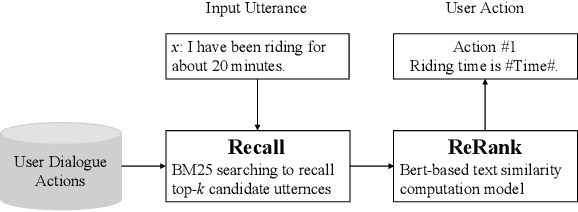

Abstract:Though widely used in industry, traditional task-oriented dialogue systems suffer from three bottlenecks: (i) difficult ontology construction (e.g., intents and slots); (ii) poor controllability and interpretability; (iii) annotation-hungry. In this paper, we propose to represent utterance with a simpler concept named Dialogue Action, upon which we construct a tree-structured TaskFlow and further build task-oriented chatbot with TaskFlow as core component. A framework is presented to automatically construct TaskFlow from large-scale dialogues and deploy online. Our experiments on real-world after-sale customer services show TaskFlow can satisfy the major needs, as well as reduce the developer burden effectively.
Capturing Event Argument Interaction via A Bi-Directional Entity-Level Recurrent Decoder
Jul 01, 2021



Abstract:Capturing interactions among event arguments is an essential step towards robust event argument extraction (EAE). However, existing efforts in this direction suffer from two limitations: 1) The argument role type information of contextual entities is mainly utilized as training signals, ignoring the potential merits of directly adopting it as semantically rich input features; 2) The argument-level sequential semantics, which implies the overall distribution pattern of argument roles over an event mention, is not well characterized. To tackle the above two bottlenecks, we formalize EAE as a Seq2Seq-like learning problem for the first time, where a sentence with a specific event trigger is mapped to a sequence of event argument roles. A neural architecture with a novel Bi-directional Entity-level Recurrent Decoder (BERD) is proposed to generate argument roles by incorporating contextual entities' argument role predictions, like a word-by-word text generation process, thereby distinguishing implicit argument distribution patterns within an event more accurately.
 Add to Chrome
Add to Chrome Add to Firefox
Add to Firefox Add to Edge
Add to Edge